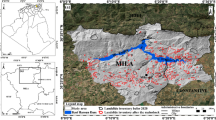Abstract
Lava deltas, formed where lava enters the ocean and builds a shelf of new land extending from the coastline, represent a significant local hazard, especially on populated ocean island volcanoes. Such structures are unstable and prone to collapse—events that are often accompanied by small explosions that can deposit boulders and cobbles hundreds of meters inland. Explosions that coincide with collapses of the East Lae ‘Apuki lava delta at Kīlauea Volcano, Hawai‘i, during 2005–2007 followed an evolutionary progression mirroring that of the delta itself. A collapse that occurred when the lava–ocean entry was active was associated with a blast of lithic blocks and dispersal of spatter and fine, glassy tephra. Shortly after delta growth ceased, a collapse exposed hot rock to cold ocean water, resulting in an explosion composed entirely of lithic blocks and lapilli. Further collapse of the delta after several months of inactivity, by which time it had cooled significantly, resulted in no recognizable explosion deposit. Seaward displacement and subsidence of the coastline immediately inland of the delta was measured by both satellite and ground-based sensors and occurred at rates of several centimeters per month even after the lava–ocean entry had ceased. The anomalous deformation ended only after complete collapse of the delta. Monitoring of ground deformation may therefore provide an indication of the potential for delta collapse, while the hazard associated with collapse can be inferred from the level of activity, or the time since the last activity, on the delta.







Similar content being viewed by others
References
Bosman A, Casalbore D, Romagnoli C, Chiocci FL (2014) Formation of an ‘a‘ā lava delta: insights from time-lapse multibeam bathymetry and direct observations during the Stromboli 2007 eruption. Bull Volcanol 76(7):838. doi:10.1007/s00445-014-0838-2
Chiocci FL, Romagnoli C, Tommasi P, Bosman A (2008) The Stromboi 2002 tsunamigenic submarine slide: characteristics and possible failure mechanisms. J Geophys Res 113(B10102) doi:10.1029/2007JB005172
Ebmeier SK, Biggs J, Mather TA, Elliott JR, Wadge G, Amelung F (2012) Measuring large topographic change with InSAR: lava thicknesses, extrusion rate and subsidence rate at Santiaguito Volcano, Guatemala. Earth Planet Sci Lett 335–336:216–225
Edmonds M, Gerlach TM (2006) The airborne lava-seawater interaction plume at Kīlauea Volcano, Hawai’i. Earth Planet Sci Lett 244(1–2):83–96
Farr TG, Rosen PA, Caro E, Crippen R, Duren R, Hensley S, Kobrick M, Paller M, Rodriguez E, Roth L, Seal D, Shaffer S, Shimada J, Umland J, Werner M, Oskin M, Burbank D, Alsdorf D (2007) The shuttle radar topography mission. Rev Geophs 45(RG2004) doi:10.1029/2005RG000183
Hooper A (2008) A multi-temporal InSAR method incorporating both persistent scatterer and small baseline approaches. Geophys Res Lett 35(L16302) doi:10.1029/2008GL034654
Kauahikaua J, Denlinger R, Foster J, Keszthelyi L (1993) Lava delta instability: is it mass-wasting or is it triggered by lava flowing through tubes? [abs.]. Eos, Trans Amer Geophys Union 74(43):616
Marie G, Sherrod DR, Kauahikaua JP (2003) Long-term instability and retreat of lava deltas of Kilauea volcano, Hawai‘i [abs.]. Cities on Volcanoes 3, Hilo, Hawaii, July 14–18, Abstract Volume, pp 82
Massonnet D, Sigmundsson F (2000) Remote sensing of volcano deformation by radar interferometry from various satellites. In: Mouginis-Mark PJ, Crisp JA, Fink JH (eds) Remote sensing of active volcanism. Geophysical Monograph 116, American Geophysical Union, Washington, DC, pp 207–221
Mattox TN, Mangan MT (1997) Littoral hydrovolcanic explosions: a case study of lava-seawater interaction at Kilauea volcano. J Volcanol Geotherm Res 75(1–2):1–17
Moore JG, Phillips RL, Grigg RW, Petersen DW, Swanson DA (1973) Flow of lava into the sea, 1969–1971, Kilauea Volcano, Hawaii. Geol Soc Am Bull 84(2):537–546
Owen S, Segall P, Lisowski M, Miklius A, Denlinger R, Sako M (2000) Rapid deformation of Kilauea Volcano: global positioning system measurements between 1990 and 1996. J Geophys Res 105(B8):18,983–18,993
Poland MP (2014) Time-averaged discharge rate of subaerial lava at Kīlauea Volcano, Hawai‘i, measured from TanDEM-X interferometry—implications for magma supply and storage during 2011–13. J Geophys Res 119(7):5464–5481. doi:10.1002/2014JB011132
Ramalho RS, Quartau R, Trenhaile AS, Mitchell NC, Woodroffe CD, Ávila SP (2013) Coastal evolution on volcanic oceanic islands: a complex interplay between volcanism, erosion, sedimentation, sea-level change and biogenic production. Earth-Sci Rev 127:140–170
Richter N, Poland MP, Lundgren PR (2013) TerraSAR-X interferometry reveals small-scale deformation associated with the summit eruption of Kīlauea Volcano, Hawai‘i. Geophys Res Lett 40(7):1279–1283
Skilling I (2002) Basaltic pahoehoe lava-fed deltas: large-scale characteristics, clast generation, emplacement processes and environmental discrimination. Geol Soc Lon Spec Publ 202:91–113
Tribble GW (1991) Underwater observations of active lava flows from Kilauea volcano, Hawaii. Geology 19(6):633–636
Umino S, Nonaka M, Kauahikaua J (2006) Emplacement of subaerial pahoehoe lava sheet flows into water: 1990 Kūpaianaha flow of Kilauea volcano at Kaimū Bay, Hawaii. Bull Volcanol 69(2):125–139
Zebker HA, Rosen P, Hensley S, Mouginis-Mark PJ (1996) Analysis of active lava flows on Kilauea Volcano, Hawaii, using SIR-C radar correlation measurements. Geology 24(6):495–498
Zebker HA, Amelung F, Jonsson S (2000) Remote sensing of volcano surface and internal processes using radar interferometry. In: Mouginis-Mark PJ, Crisp JA, Fink JH (eds) Remote sensing of active volcanism. Geophysical Monograph 116, American Geophysical Union, Washington, DC, pp 179–205
Acknowledgments
We are grateful to Asta Miklius for processing the GPS data from the delta station, and to the variety of Hawaiian Volcano Observatory staff and volunteers, as well as National Park Service rangers, who documented lava-delta activity at East Lae ‘Apuki. ENVISAT data were provided via the Hawai‘i Supersite courtesy of the European Space Agency. The manuscript benefited from suggestions by Matt Patrick and two anonymous reviewers.
Author information
Authors and Affiliations
Corresponding author
Additional information
Editorial responsibility: S. Calvari
Rights and permissions
About this article
Cite this article
Poland, M.P., Orr, T.R. Identifying hazards associated with lava deltas. Bull Volcanol 76, 880 (2014). https://doi.org/10.1007/s00445-014-0880-0
Received:
Accepted:
Published:
DOI: https://doi.org/10.1007/s00445-014-0880-0




